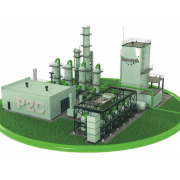New SINTEF Project: Recycling EPS from Construction Sector
Tons of reusable polystyrene ends up as plastic waste when buildings are demolished. Researchers want to see more recycling and reuse.
According to the Norwegian independent research organization SINTEF, stringent energy efficiency requirements in the building sector mean installing more insulation than ever before. “Every year, we manufacture and import tens of thousands of tons of plastic pellets for the production of insulation materials. At the same time, we are sending volumes of insulation materials equivalent to one-third of what we actually use to landfill and combustion plants.” In order to prevent so much plastic waste from ending up in landfill or combustion ovens, new systems for waste sorting, disposal, reuse and recycling of building materials had to be developed.
That would benefit both the industry and the environment, Birgit Risholt, a researcher at the Norwegian science institute, is convinced. The Senior Research Scientist at SINTEF is heading the project ‘Sirkulær EPS’ (Circular EPS), which aims to recycle EPS (Expanded Polystyrene) insulation materials from the building and construction industry.
“The establishment of a so-called ‘circular economic value chain’ will improve access to insulation materials and reduce the need for the expensive disposal of demolition waste” SINTEF underlined. The goal is to adapt materials reuse and recycling to future needs; the work is being carried out in collaboration with the building industry.
The entire industry has to get behind this approach
As reported, the project owner is the company BEWI (formerly Jackon), which supplies construction systems and insulation materials to the building and construction industry. “It is now looking to take the lead in the use of recycled materials. BEWI’s objective is to use as much as 50 percent recirculated raw materials in its future manufacture of EPS, which is a more ambitious target than is required by current regulations. In order to achieve this goal, the company will have to get access to large volumes of EPS waste from the construction sector, both from new-build projects and demolitions.” At present, used EPS can be recovered from buildings throughout Norway. It takes up a lot of space and is thus expensive to transport. Used EPS may also be contaminated with dirt or chemicals. For these reasons, a logistical system is needed to compress used EPS to make it ready for transport, as well as a method for separating and removing contaminating substances.
“We’re very pleased to have companies such as Optimera and Franzefoss Gjenvinning on our team during this project. Together, we’ll succeed in finding a logistical solution”, Tone-Cecilie Lie, Senior Sustainability Manager at BEWI, was cited. “But in order for us to get hold of sufficient used EPS, the entire value chain will have to get behind the new approach. We can never have enough partners.”
Assessing the potential for reuse
SINTEF is acting as coordinator and research partner during this project. Its role is to make an assessment of existing building stock to find out how much EPS there is and the potential for its reuse. It is also important to find out if the materials can be reused in their current form, or if they have to be processed in some way. “Before we can reuse EPS that is recovered from demolished buildings, we have to make sure that it doesn’t contain any harmful substances”, Birgit Risholt informed. “For example, we know that some EPS used in the 1980s contains brominated flame retardants. It will not be possible to reuse this kind of material in new buildings.” Furthermore, SINTEF will be testing different technical building solutions involving recycled EPS in its laboratories.
Researchers will also be looking into costs, market scenarios and the need to adapt the regulatory framework to make recycling and the trade in such materials easier, the research organization assured.
Looking for EPS from demolition projects
BEWI’s factory in Fredrikstad in south-eastern Norway has already initiated the test manufacture of EPS using recycled raw materials. When the project partners met at the beginning of June, they were able to pool their experience as a basis for preparing plans for their future research activities. “We’re going to need a great deal of used EPS from demolition projects, so if you’re looking to renovate a large roof or demolish a building that has EPS in its construction, don’t hesitate to get in touch with us”, Birgit Risholt was quoted.
(Published in GLOBAL RECYCLING Magazine 3/2023, Page 14, Photo: O. Kürth)








